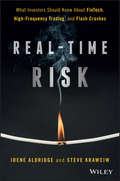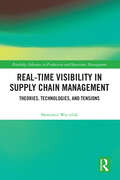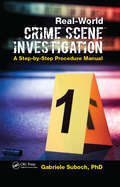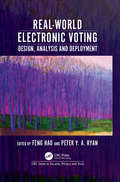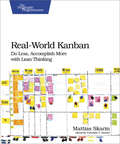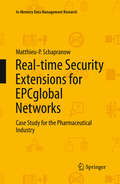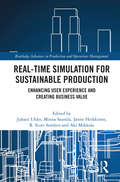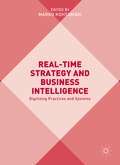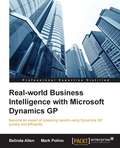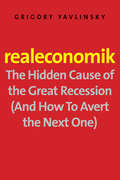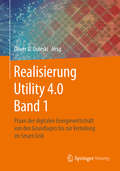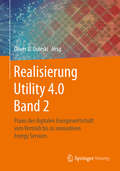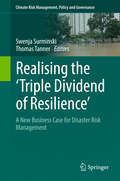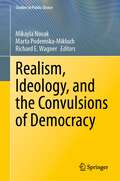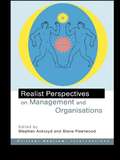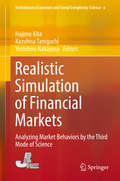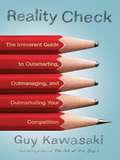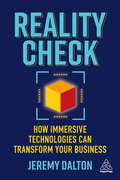- Table View
- List View
Real-Time Risk: What Investors Should Know About FinTech, High-Frequency Trading, and Flash Crashes
by Irene Aldridge Steven KrawciwRisk management solutions for today's high-speed investing environment Real-Time Risk is the first book to show regular, institutional, and quantitative investors how to navigate intraday threats and stay on-course. The FinTech revolution has brought massive changes to the way investing is done. Trading happens in microsecond time frames, and while risks are emerging faster and in greater volume than ever before, traditional risk management approaches are too slow to be relevant. This book describes market microstructure and modern risks, and presents a new way of thinking about risk management in today's high-speed world. Accessible, straightforward explanations shed light on little-understood topics, and expert guidance helps investors protect themselves from new threats. The discussion dissects FinTech innovation to highlight the ongoing disruption, and to establish a toolkit of approaches for analyzing flash crashes, aggressive high frequency trading, and other specific aspects of the market. Today's investors face an environment in which computers and infrastructure merge, regulations allow dozens of exchanges to coexist, and globalized business facilitates round-the-clock deals. This book shows you how to navigate today's investing environment safely and profitably, with the latest in risk-management thinking. Discover risk management that works within micro-second trading Understand the nature and impact of real-time risk, and how to protect yourself Learn why flash crashes happen, and how to mitigate damage in advance Examine the FinTech disruption to established business models and practices When technology collided with investing, the boom created stratospheric amounts of data that allows us to plumb untapped depths and discover solutions that were unimaginable 20 years ago. Real-Time Risk describes these solutions, and provides practical guidance for today's savvy investor.
Real-Time Visibility in Supply Chain Management: Theories, Technologies, and Tensions (Routledge Advances in Production and Operations Management)
by Sławomir WyciślakReal-Time Visibility in Supply Chain Management applies the paradox theory to understand why real-time visibility expectations and aspirations do not meet supply chain realities. Providing an understanding of the governance of industrial digital platforms for real-time visibility, the book identifies paradoxical tensions among platform partners and explores how to navigate them.The author conceptualizes dynamic patterns of tension evolution among supply chain platform partners and suggests future research directions to advance theorization regarding platform governance and tensions. The successful implementation of digital platforms requires understanding and navigating these paradoxical tensions. The perspective of paradox theory offered in this book can advance our supply chain digitalization understanding as it informs about gaps in thought processes, methodologies, tools, and solutions. The book also explores the role of multiple stakeholders, including platform owners, customers and complementors, in operationalizing real-time visibility to offer new theoretical insights.This book will appeal to researchers and scholars in the areas of supply chain management, operations and logistics, as well as those interested in digitalization and technology management.
Real-World Crime Scene Investigation: A Step-by-Step Procedure Manual
by Gabriele SubochReal-World Crime Scene Investigation: A Step-by-Step Procedure Manual is designed as a field guide providing instruction on how to document a crime scene, including sketching, mapping, searching, collecting, and preserving physical evidence. It also addresses how to document a crime scene using photography and videography. It introduces modern fore
Real-World Electronic Voting: Design, Analysis and Deployment (Series in Security, Privacy and Trust)
by FENG HAO AND PETER Y. A. RYANReal-World Electronic Voting: Design, Analysis and Deployment captures all major developments in electronic voting since 2003 in a real-world setting. It covers three broad categories: e-voting protocols, attacks reported on e-voting and new developments on the use of e-voting. This book explores recent innovations in both poll-site and remote voting systems and their application throughout the world. The requirements of elections are analysed, the available tools and technologies are described, and a variety of modern systems are presented in detail together with discussions of deployments. This is an invaluable resource for election professionals, researchers and policy makers alike. Key Features: Reviews both technical and social aspects of e-voting Covers e-voting protocols, attacks reported on e-voting and new developments on the use of e-voting Designed for government election practitioners and policy makers who want to understand the threats and opportunities in e-voting and assess its suitability for future elections
Real-World Kanban: Do Less, Accomplish More with Lean Thinking
by Mattias SkarinYour team is stressed; priorities are unclear. You're not sure what your teammates are working on, and management isn't helping. If your team is struggling with any of these symptoms, these four case studies will guide you to project success. See how Kanban was used to significantly improve time to market and to create a shared focus across marketing, IT, and operations. Each case study comes with illustrations of the Kanban board and diagrams and graphs to help you see behind the scenes.Learn a Lean approach by seeing how Kanban made a difference in four real-world situations. You'll explore how four different teams used Kanban to make paradigm-changing improvements in software development. These teams were struggling with overwork, unclear priorities, and lack of direction. As you discover what worked for them, you'll understand how to make significant changes in real situations.The four case studies in this book explain how to: Improve the full value chain by using Enterprise Kanban Boost engagement, teamwork, and flow in change management and operations Save a derailing project with Kanban Help an office team outside IT keep up with growth using KanbanWhat seems easy in theory can become tangled in practice. Discover why "improving IT" can make you miss your biggest improvement opportunities, and why you should focus on fixing quality and front-end operations before IT. Discover how to keep long-term focus and improve across department borders while dealing with everyday challenges. Find out what happened when using Kanban to find better ways to do work in a well-established company, including running multi-team development without a project office. You'll inspire your team and engage management to make it easier to develop better products.What You Need:This is a case study book, so there are no software requirements. The book covers the relevant bits of theory before presenting the case studies.
Real-World Time Management (WorkSmart)
by Michael S. Dobson Roy AlexanderIn this instructive guide to time management, author Michael Dobson provides tips, techniques, and commonsense advice that will give anyone better agency over his or her time and significantly increase productivity. Real-World Time Management does this by offering readers valuable tips on how to: set priorities; stay on track; keep a closed-door policy; avoid interrupters; and reduce stress. You’ll also learn how to handle distractions, stop procrastinating, delegate tasks, deal with meetings, and manage time effectively while traveling.Most of us dream about having a few extra hours in our day for taking care of business, relaxing, or engaging in the activities we most enjoy. But how can we make the most of our time when it seems as though there aren’t enough hours in the day? Now newly updated, this enlightening and essential guide will help leaders and frontline employees alike wrangle and order their time--no matter how hectic their lives may seem.
Real-time Security Extensions for EPCglobal Networks: Case Study for the Pharmaceutical Industry
by Matthieu-P. SchapranowThe transformation towards EPCglobal networks requires technical equipment for capturing event data and IT systems to store and exchange them with supply chain participants. For the very first time, supply chain participants thus need to face the automatic exchange of event data with business partners. Data protection of sensitive business secrets is therefore the major aspect that needs to be clarified before companies will start to adopt EPCglobal networks. This book contributes to this proposition as follows: it defines the design of transparent real-time security extensions for EPCglobal networks based on in-memory technology. For that, it defines authentication protocols for devices with low computational resources, such as passive RFID tags, and evaluates their applicability. Furthermore, it outlines all steps for implementing history-based access control for EPCglobal software components, which enables a continuous control of access based on the real-time analysis of the complete query history and a fine-grained filtering of event data. The applicability of these innovative data protection mechanisms is underlined by their exemplary integration in the FOSSTRAK architecture.
Real-time Simulation for Sustainable Production: Enhancing User Experience and Creating Business Value (Routledge Advances in Production and Operations Management)
by Juhani UkkoThis book provides a comprehensive overview of potential opportunities and the business value position related to implementing physics-based real-time simulation to production. The objective of real-time simulation is to provide value for all three dimensions of sustainability: economic, social, and environmental. By reviewing actual industrial cases and presenting relevant academic research, the book examines the topic from four interrelated viewpoints: the industrial need for sustainable production, the development of game-like virtual environments, capturing customer value and enhancing the user experience, and finally, establishing business value. It offers a framework that will enable a rethink and shift in mindset to appreciate how real-time simulation can change the way products are manufactured and services are produced. This book will appeal to researchers and scholars in areas as diverse as strategic management, manufacturing and operations management, marketing, industrial economics, and product lifecycle management.
Real-time Strategy and Business Intelligence
by Marko KohtamäkiThis book discusses and conceptualizes practices on real-time strategy, focusing on the interplay between strategy and business intelligence. Combining strategic practices and business intelligence systems, the authors demonstrate how managerial practices can be developed in the age of digitization. Also developing the concept of strategic agility, the book provides perspectives from a range of disciplines including strategic practices and decision making, customer relationship management, human resource management, competitive intelligence, supplier network management and business intelligence systems. Presenting managerial frameworks and guidelines, Real-time Strategy and Business Intelligence explores how to improve utilization of business intelligence systems in real-time decision making. Providing practical and future-oriented insights backed by examples and best practices, the authors present a clearly conceptualized theoretical framework.
Real-world Business Intelligence with Microsoft Dynamics GP
by Belinda Allen Polino MarkIf you're a GP user, this book is aimed at making your job easier. How? Through the use of Business Intelligence (BI) provided by your Microsoft Dynamics GP software to aid you in making informed decisions. This book assumes no previous experience; however, a basic knowledge of Excel is expected.
RealNetworks Rhapsody
by Thomas R. Eisenmann Steven CarpenterExamines RealNetwork's (Real's) strategy for the rapidly emerging online music market. In contrast to rivals who sell individual copies of songs, Real offers online music on a subscription basis. For a $10 monthly fee, subscribers to Real's Rhapsody service have unlimited rights to stream all songs from a 600,000-title library to any PC and can burn CD copies of these songs for 79 cents apiece. Real faces significant marketing challenges in persuading consumers to "rent" rather than own their music. The company must decide which channel partners--broadband access providers, consumer electronics retailers, PC manufacturers, or portals--are best equipped to help sell its services. Finally, Real must determine how to differentiate its services from those soon to be offered by a glut of new competitors poised to enter the online music market, including Wal-Mart, Viacom, Sony, Dell, and Microsoft.
Realeconomik: The Hidden Cause of the Great Recession (and How to Avert the Next One)
by Grigory YavlinskyThis book directly confronts uncomfortable questions that many prefer to brush aside: if economists and other scholars, politicians, and business professionals understand the causes of economic crises, as they claim, then why do such damaging crises continue to occur? Can we trust business and intellectual elites who advocate the principles of Realpolitik and claim the "public good" as their priority, yet consistently favor maximization of profit over ethical issues? Former deputy prime minister of Russia Grigory Yavlinsky, an internationally respected free-market economist, makes a powerful case that the often-cited causes of global economic instability--institutional failings, wrong decisions by regulators, insufficient or incorrect information, and the like--are only secondary to a far more significant underlying cause: the failure to understand that universal social norms are essential to thriving businesses and social and economic progress. Yavlinsky explores the widespread disregard for moral values in business decisions and calls for restoration of principled behavior in politics and economic practices. The unwelcome alternative, he warns, will be a twenty-first-century global economy in the grip of unending crises.
Realigning Your Resource Portfolio: Staying Competitive with the Resource Pathways Framework
by Will Mitchell Laurence CapronChapter 6 of "Build, Borrow, or Buy: Solving the Growth Dilemma" shows you how to use the "resource pathways framework" to continuously realign your organization's portfolio, shifting some resources into more value-creating activities, revitalizing others by combining them with new resources, and completely divesting those that no longer add value. Using the framework as an ongoing portfolio management activity can help keep your firm focused and competitive. *About the book:* How should you grow your organization? It's one of the most challenging questions an executive team faces--and the wrong answer can break your firm. The problem is, most firms' strategies emphasize just one type of growth--for example, some focus on organic growth, others on M&A. When these strategies falter, the common response is simply to try harder. Instead, firms need to find the pathway that is right for them, argue INSEAD's Laurence Capron and coauthor Will Mitchell, of Duke University's Fuqua School of Business and the Rotman School of Management at the University of Toronto. The result of a decade of research and teaching, their "resource pathways framework" helps organizations find that path. It is built around three strategic questions: (1) BUILD: Are your existing internal resources relevant for developing the new resources that you have targeted for growth? (2) BORROW: Could you obtain the targeted resources via an effective relationship with a resource partner? and (3) BUY: Do you need broad and deep relationships with your resource provider? Written for managers of large multinationals and emerging firms alike, "Build, Borrow, or Buy" will help solve a perennial question and guide you through change, while priming your organization for optimal growth.
Realisierung Utility 4.0 Band 1: Praxis der digitalen Energiewirtschaft von den Grundlagen bis zur Verteilung im Smart Grid
by Oliver D. DoleskiBei der Digitalisierung des Energiesektors von Praxiserfahrungen anderer Experten profitieren! Dieser bewährten Devise folgend zeigen Autoren aus Versorgungs- und IT-Unternehmen, Beratungen und Start-ups ausgewählte Lösungen für eine erfolgreiche digitale Transformation der Energiebranche. Durch die Lektüre der ersten zweibändigen Fachpublikation zur Digitalisierung der Energiewirtschaft im deutschsprachigen Raum kann der Leser von Expertenwissen profitieren und seinen Nutzen aus realen Anwendungsfällen sowie der Beschreibung umgesetzter Geschäftsmodelle der digitalen Energiewelt ziehen.In Band 1 werden die wesentlichen Grundlagen des digitalen Business in der Energiewirtschaft präsentiert. Dem Einführungsteil folgen vier Abschnitte zu unterschiedlichen Facetten der Digitalisierung entlang der energiewirtschaftlichen Wertschöpfung von der Erzeugung bis zur Verteilung im Smart Grid.
Realisierung Utility 4.0 Band 2: Praxis der digitalen Energiewirtschaft vom Vertrieb bis zu innovativen Energy Services
by Oliver D. DoleskiBei der Digitalisierung des Energiesektors von Praxiserfahrungen anderer Experten profitieren! Dieser bewährten Devise folgend zeigen Autoren aus Versorgungs- und IT-Unternehmen, Beratungen und Start-ups ausgewählte Lösungen für eine erfolgreiche digitale Transformation der Energiebranche. Durch die Lektüre der ersten zweibändigen Fachpublikation zur Digitalisierung der Energiewirtschaft im deutschsprachigen Raum kann der Leser von Expertenwissen profitieren und seinen Nutzen aus realen Anwendungsfällen sowie der Beschreibung umgesetzter Geschäftsmodelle der digitalen Energiewelt ziehen. Band 2 führt die Gliederung entlang der energiewirtschaftlichen Wertschöpfung des ersten Bands fort. Das Spektrum reicht von den vertrieblichen Aspekten der digitalen Energiewelt bis hin zu Praxisbeiträgen zum Zusammenwachsen von Energie, Mobilität, Kommunikation und Stadtentwicklung.
Realising the 'Triple Dividend of Resilience'
by Swenja Surminski Thomas TannerWhy aren't we investing more in disaster resilience, despite the rising costs of disaster events? This book argues that decision-makers in governments, businesses, households, and development agencies tend to focus on avoiding losses from disasters, and perceive the return on investment as uncertain - only realised if a somewhat unlikely disaster event actually happens. This book develops a new business case for investment based on the multiple dividends of resilience. This looks beyond only avoided losses (the first dividend) to the wider benefits gained independently of whether or not the disaster event occurs. These include unleashing entrepreneurial activities and productive investments by lowering the looming threat of losses from disasters and enabling businesses, farmers and homeowners to take positive risks (the second dividend); and co-benefits of resilience measures beyond just disaster risk (the third dividend), such as flood embankments in Bangladesh that double as roads, or wetlands in Colombo that reduce urban heat extremes.
Realism for Social Sciences: A Translational Approach to Methodology (Translational Systems Sciences #36)
by Yoshiyuki Takeuchi Ken Urai Masaaki KatsuragiThis book discusses the growing interest in realism in social sciences of the twenty-first century. The first part of this book provides recent discussions on realism in philosophy. The second part describes specific problems that have returned to realism in various fields of the social sciences, such as economics, cultural anthropology, management science, and statistics. This book clarifies what kinds of movements are taking place and consequently the direction in which the social sciences are heading in the future. Readers would also find that there is great diversity in the way realism and reality are perceived and understood, depending on the objectives and circumstances of each field of social science. This suggests that rather than having a unified view (stance) of realism and reality, it may be more meaningful to value the differences, diversity, and range itself. Therefore, this book does not present a unified view of realism, reality, and actuality. Although the definitions of realism and reality may differ from chapter to chapter, this represents a corner of the current state of the social sciences. This book is unique in that it examines how the issues of realism and reality are viewed, understood, and dealt with in the various fields of social science, instead of examining them by philosophers and philosophers of science. This would clarify how philosophical discussions have been translated into the various fields of social science.
Realism, Ideology, and the Convulsions of Democracy (Studies in Public Choice #44)
by Mikayla Novak Richard E. Wagner Marta Podemska-MikluchThis edited volume explores the tension between reason and sentiment in democracies and its contribution to the decline of liberalism. Bringing together classical liberal scholars with a deep knowledge of public choice ideas, the chapters delve into this tension from a variety of perspectives. Building on the principle of entangled political economy, as articulated by Richard E. Wagner, this volume engages with new facets of the relationship between choice and consequence and their implications for democratic politics. Advocating for a reframing of public choice theory as compatible with civic republicanism, this volume will be of interest to students and scholars of public choice, political economy, political theory, governance, and economic policy.
Realist Perspectives on Management and Organisations (Critical Realism Ser.)
by Steve Fleetwood Stephen AckroydRealism has been one of the most powerful new developments in philosophy and the social sciences and is now making an increasing impact in business and management studies. This is the first book-length treatment of critical realism in business and management. It pulls together a wide range of material which is all explicitly or implicitly rooted in philosophical realism, and combines theoretical writing with substantive contributions addressing issues such as the nature of the firm and the labour process which together demonstrates that realism is a powerful alternative to postmodernism and positivism.
Realistic Optimism: A Sense of Agency--How Great Leaders' Belief in Their Ability to Determine Outcomes Empowers Entire Organizations
by Justin MenkesOne of the qualities that sets great leaders apart is their belief that their own actions make a difference--that they can influence outcomes. In this chapter, psychologist and executive assessment expert Justin Menkes explores this sense of agency and why it can be such a game changer for aspiring leaders. Using powerful testimonials from master CEOs--Chevron's Dave O'Reilly, Continental Airlines' Gordon Bethune, Kraft Food's Irene Rosenfeld, and Scripps Health Systems' Chris Van Gorder--Menkes shows how you can energize an entire workforce by intensifying its sense of agency. Each of the relentless leaders quoted in this chapter recognizes that success is dependent on our own actions, and regardless of outside events beyond our control, it is how we react to the realities in front of us that determines whether we succeed or fail. The chapter concludes with suggestions about how you can use metrics and feedback to help your people accept greater accountability, overcome seemingly intractable problems, and achieve at their highest levels. This chapter was originally published as Chapter 3 of "Better Under Pressure: How Great Leaders Bring Out the Best in Themselves and Others."
Realistic Optimism: An Awareness of Actual Circumstances--How Great Leaders Balance Known and Unknown Challenges to Determine a Course of Action
by Justin MenkesMany leaders under duress try to downplay the risks involved in the circumstances they are confronting. They ignore critical facts or focus on solvable problems instead of the larger, more ambiguous challenges they face. But to be a great leader in today's economy, you must recognize that the world of enterprise faces colossal ambiguity--and you must strike a balance between the known and the unknown. In this chapter, psychologist and executive assessment expert Justin Menkes explains how great leaders achieve this balance and maximize their odds of success amidst constant uncertainty: they use an attribute he calls "realistic optimism"--the first of three catalysts that determine a relentless leader's ability to realize his or her own potential, and the potential of others, in a world of duress. The chapter shows you how to develop a critical awareness of actual circumstances--especially when you look at yourself. Through vivid real-life examples, including the experiences of Kevin Sharer, CEO of Amgen, and Gillette's James Kilts, you'll also discover the role humility plays in a leader's ability to face reality, thrive in it, and create an "elastic" organization that can rise to the challenges of today's ever-changing business environment. This chapter was originally published as Chapter 2 of "Better Under Pressure: How Great Leaders Bring Out the Best in Themselves and Others."
Realistic Simulation of Financial Markets
by Hajime Kita Kazuhisa Taniguchi Yoshihiro NakajimaThis book takes up unique agent-based approaches to solving problems related to stock and their derivative markets. Toward this end, the authors have worked for more than 15 years on the development of an artificial market simulator called U-Mart for use as a research and educational tool. A noteworthy feature of the U-Mart simulator compared to other artificial market simulators is that U-Mart is an ultra-realistic artificial stock and their derivative market simulator. For example, it can simulate "arrowhead," a next-generation trading system used in the Tokyo Stock Exchange and other major markets, as it takes into consideration the institutional design of the entire market. Another interesting feature of the U-Mart simulator is that it permits both human and computer programs to participate simultaneously as traders in the artificial market. In this book, first the details of U-Mart are explained, enabling readers to install and run the simulator on their computers for research and educational purposes. The simulator thus can be used for gaming simulation of the artificial market and even for users as agents to implement their own trading strategies for agent-based simulation (ABS). The book also presents selected research cases using the U-Mart simulator. Here, topics include automated acquisition of trading strategy using artificial intelligence techniques, evaluation of a market maker system to treat thin markets such as those for small and regional businesses, systemic risk analysis of the financial market considering institutional design of the market, and analysis of how humans behave and learn in gaming simulation. New perspectives on artificial market research are provided, and the power, potential, and challenge of ABS are discussed. As explained in this important work, ABS is considered to be an effective tool as the third approach of social science, an alternative to traditional literary and mathematical approaches.
Reality Check
by Guy Kawasaki"Don't even think about trying to launch a startup without reading Guy Kawasaki's Reality Check." -BizEd For a quarter of a century, in his various guises as an entrepreneur, evangelist, venture capitalist, and guru, Guy Kawasaki has cast an irreverent eye on the dubious trends, sketchy theories, and outright foolishness of what so often passes for business today. Too many people frantically chase the Next Big Thing only to discover that all they've made is the Last Big Mistake. Reality Check is Kawasaki's all-in-one guide for starting and operating great organizations-ones that stand the test of time and ignore any passing fads in business theory. This indispensable volume collects, updates, and expands the best entries from his popular blog and features his inimitable take on everything from effective e-mailing to sucking up to preventing "bozo explosions."
Reality Check: How Immersive Technologies Can Transform Your Business
by Jeremy DaltonDiscover the next big competitive advantage in business and learn how augmented and virtual reality can put your business ahead.Augmented reality (AR) and virtual reality (VR) are part of a new wave of immersive technologies that offer huge opportunities for businesses, across industries and regardless of their size. Most people think of AR or VR as a new development in video gaming like Pokémon GO, or an expensive marketing campaign by the Nikes of the world. The truth is, businesses of any size can put these new technologies to immediate use in areas that include training and development, customer experience and design, as well as data and information management. Reality Check dispels the common misconceptions of AR and VR, such as them being too expensive or not easily scalable, and details how business leaders can integrate them into their business to deliver more efficient, cost-sensitive and exciting business solutions. The up and coming voice of AR and VR for businesses, Jeremy Dalton, uses exclusive case studies from organizations like Lloyds Banking Group, Honeywell and IKEA to showcase the practical uses of immersive technologies. He argues businesses will see the most immediate benefits in four areas: - Training- Design- Information and data- Telepresence Reality Check makes cutting-edge technology accessible and grounds them into the everyday workings of normal businesses. It is your one-stop non-technical guide to incredibly exciting new technologies that will deliver results.
Reality Check: How VR and AR Can Supercharge Your Business
by Jeremy DaltonImmersive technologies have the power to radically transform your business. Discover how you can step into the future and gain competitive advantage with Reality Check.Virtual and augmented reality has existed for years, yet most of us rarely use them beyond gaming and tech demos. This book separates hype from reality to uncover how these groundbreaking techxnologies are transforming our world, offering huge business opportunities across all sectors.Reality Check features fascinating real-life examples and interviews with industry leaders which dispel common misconceptions, explore the future of technology and uncover how VR and XR can be integrated into your business, improving efficiency, impact and productivity.
